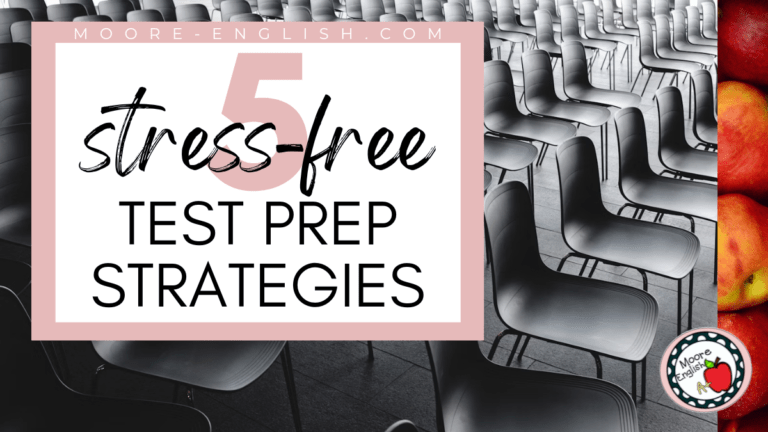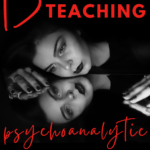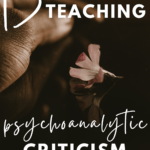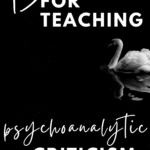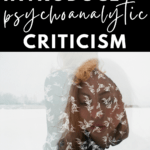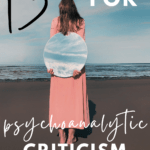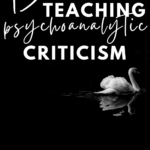Psychoanalytical criticism is a complex critical lens. The different levels of psychoanalytical criticism make it challenging for students and, sometimes, uncomfortable for teachers. For these reasons, when I introduce psychoanalytical criticism to my juniors, I try to keep it simple. Here’s what we focus on:
- a brief introduction to Freud
- quick notes about the ego, ID, and Superego
- an acknowledgement that there is more to psychoanalytical criticism but that we are using the “starter pack”
- and, perhaps most importantly, that applying psychoanalytical criticism does not make us mental health experts, so we are not going to diagnose characters (or each other)
To help students apply psychoanalytical criticism, we focus on these questions:
- Which characters exhibit balance? Which characters lack balance in their lives?
- On the other hand, which characters are always logical, in control, and never lose restraint?
- Are any of the characters reckless, spiraling out of control, or giving in to their base instincts?
- How do the characters’ personalities, flaws, and strengths lead to the text’s climax and resolution?
This post this post may contain affiliate links. Please read the Terms of Use.
Introducing Psychoanalytical Criticism
Sometimes it’s easiest to introduce psychoanalytical criticism by starting with a familiar text. By the time students reach me, they are familiar with the story of Icarus. To refresh their memories, I like to use this version of the myth as told by Josephine Preston Peabody.
Beginning with the story of Icarus is helpful because the text is non-threatening, short, and has a clear resolution. Plus, Icarus can easily be read as representing the ID. Students often debate whether his father Daedalus represents the ego or the Superego. By the time students are engaged in that debate, I know they are starting to understand this critical lens.
To extend our understanding of psychoanalytical criticism, we may continue with the Icarus theme and see how other authors interpret his actions:
- First, “Poor Icarus” by Florence Earle Coates offers a different interpretation. By reading an alternative version of the myth, students can practice applying psychoanalytical criticism in a different manner. In particular, they can apply psychoanalytical criticism to the speaker of the poem, who seems to long for the ID. Read the poem here.
- Similarly, “Icarus” by Maurice Baring offers an interpretation that also values Icarus’ bravery. Again, applying psychoanalytical criticism to this text challenges students to consider the value of the ID. Read the poem here.
- Finally, “Failing and Flying” by Jack Gilbert offers a more modern interpretation of the Icarus story. As a longer poem, this text shows students a speaker that is grappling with their own ego, Superego, and ID. This is the most complex text included so far, but is also invites the greatest opportunity to psychoanalytical criticism. Read it here.
Grab all four of these resources and one more in the Synthesis Bundle #7: The Fall of Icarus!
Short Stories
As students become more adept with psychoanalytical criticism, we move to short stories.
- First, “A White Heron” by Sarah Orne Jewett has a clear plot, so students can spend more time on the literary criticism and less time on comprehension. In the text, the hunter clearly represents the ID. The main character, then, represents the conflict between her ID and ego. Read it here.
- Second, “Editha” by William Dean Howells is a more complex story, but students usually have such a strong opinion about the main character that it’s worth it! The main character provides a cautionary example of acting with ID alone. Plus, this text lends itself to historical criticism! Read it here.
- Third, “The Jilting of Granny Weatherall” by Katherine Anne Porter might be the shortest story here, but the stream of consciousness provides a different kind of challenge. The main character’s failing health makes for a great example of what happens when the ID appears in a character who is not an intentional villain. Read it here.
- Finally, “A New England Nun” by Mary E. Freeman is my favorite short story! The conflict between the main characters is all about dominance of the Superego. While the characters in this story resist the ID, they nevertheless struggle to achieve a sense of balance. Read it here.
Grab all my lesson plans for these short stories plus “A Worn Path” and lessons for 5 other short stories in the 9-12 Short Stories Bundle!
Longer Works
Once students have learned about a variety of critical lenses, it’s time to move to more complex and longer works. When choosing a longer text, I prefer one that covers multiple critical lenses. Here are some longer works that lend themselves to psychoanalytical criticism.
- To begin, the conflict in several of William Shakespeare’s comes from characters without a sense of balance. First, Romeo and Juliet could easily be read as giving into their ID (a trait they may have learned from their parents) while the Prince is a force of order and the Superego. Similarly, Macbeth initially struggles with his ego before giving into his ID. Finally, the characters in Julius Caesar believe they are agents of balance but are mostly driven by selfish needs. Grab all my Shakespeare resources in one bundle!
- Similarly, The Crucible by Arthur Miller provides a picture of a society without balance. Most of the characters are driven by “private vengeance” and the ID. However, Danforth’s lack of flexibility shows the danger of living with the Superego alone, and John Proctor’s internal conflict can be read as a war between ID and ego. Check out my favorite activities for teaching The Crucible.
- Finally, Pride and Prejudice by Jane Austen lends itself to all levels of psychoanalytical criticism. Like the characters in “A New England Nun,” the main characters largely struggle with the Superego and ego. Because the characters in this novel have so many motives, they lend themselves to a variety of critical interpretations. These are my favorite strategies for getting students engaged in Pride and Prejudice!
Further Reading
Since literary criticism is one of my passions, I’ve written quite a bit about it. Check out these related posts and resources:
- 5 Reasons to Include Literary Criticism, and 5 Ways to Make it Happen
- How to Introduce Deconstructionist Literary Criticism
- Teaching at the Intersection of History and Literature
- 8 Ways to Bring Creativity into the Classroom
- 40 Texts for Teaching Literary Criticism
- Historical and Biographical Criticism
- Deconstructionist Criticism Bundle
- All Literary Criticism Resources
- Introducing Literary Criticism
- Feminist Criticism Bundle
- Historical Criticism




